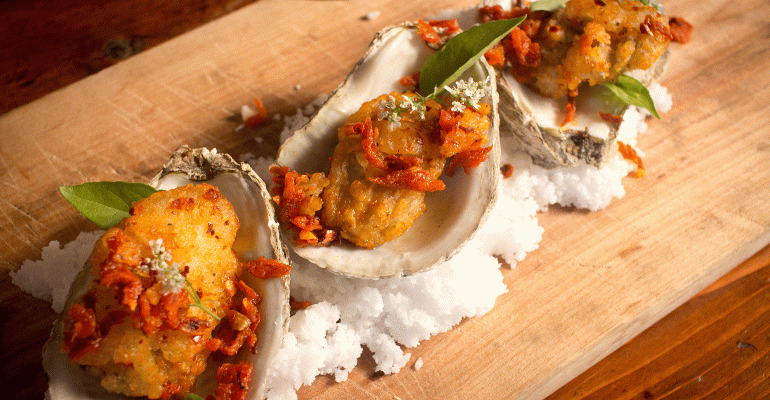Mollusk dishes — specifically mussels, clams and oysters — are going international of late, a testament to consumers’ more assertive tastes and a long-term trend toward ethnic cuisine and global flavors on menus.
“The first time I had mussels was at a Belgium-inspired restaurant, classically served with fries and made with a white wine sauce … they were simply amazing,” said Maneet Chauhan, co-owner and executive chef of Chauhan Ale and Masala House in Nashville.
But to Chauhan the dish was missing something. Something Indian.
“I thought if I could just put some of my favorite Indian spices in it, then it would become even more of a classic dish I love,” he said.
 Now on Chauhan’s menu is Goan Style Mussels, left, her version of white wine mussels and fries served instead with spicy coconut curry, grilled lime and artisan grilled bread.
Now on Chauhan’s menu is Goan Style Mussels, left, her version of white wine mussels and fries served instead with spicy coconut curry, grilled lime and artisan grilled bread.
According to Datassential MenuTrends Seafood Keynote 2017, ethnic and regional terms and ingredients appear among the fastest growing flavors, preparation methods and sides in seafood entrées. Think flavors like furikake, gremolata and Thai basil; prep methods such as poke and crudo; and accompaniments such as kimchi and coconut rice.
In April, chef Bryant Ng of Cassia in Santa Monica, Calif., transformed a traditional seafood stew into what some have likened to a Vietnamese-flavored New England Clam Chowder.
The new Seafood Pan Roast Stew is a creamy thick stew with oysters, crab, shrimp, candied bacon, coconut milk, lemon grass and kaffir lime leaf, served in a bowl over Jasmine rice. Originally on the menu a year ago as a straight stew, after bringing home some leftovers of it for dinner, along with some rice, Ng decided the dish would be even better when thickened and combined with rice.
Other restaurants pairing Asian flavors with mollusks include Harlowe MXM in Dallas, which is serving Thai Oysters, a dish of fried oysters topped with chile, cilantro and kewpie mayonnaise; and Seattle’s Bookstore Bar & Café, which is offering Spicy Miso Clams, made with steamed Manila clams in miso broth with onion, baby bok choy, fermented soybean, garlic and chile oil, served with grilled slices of bread smeared with spicy black garlic spread.

Seafood stew goes from traditional to Vietnamese-style at Cassia in Santa Monica.
Estiatorio Milos, a Greek fine-dining concept with locations in Las Vegas, London, Miami, Montréal and New York as well as Athens, Greece, is serving chilled oysters on the half-shell with raspberry mignonette, a lemon wedge and a fruity vinegar with shallots.
Chef and owner Costas Spiliadis said he is using the raspberry mignontte, in part, because it adds vibrant color to the plate, but also because he wanted to pair the oysters with two indigenous Greek wine varieties, a Sideritis from the area of Patras and Asyrtiko from Santorini.
“A raspberry mignonette added to the oysters pairs beautifully with both of these wines,” he said.
At Oyster Bah in Chicago, mussels from Prince Edward Island in Canada get a tropical treatment in the Aloha Mussels, made with a poke-style ginger-sesame marinade and red Fresno peppers.
"The quality of the PEI mussel that we use is such a great carrier of flavors and we wanted to pair it up with a really popular, trend which is poke,” managing partner Bill Nevruz said.
At Chloe in Washington, D.C., chef Haidar Karoum serves an American menu with international twists and a strong focus on seafood. Karoum, who has Lebanese roots, is currently serving local oysters Scandinavian style: broiled with horseradish glaze, rutabaga, sauerkraut and brown butter crumble.
Meanwhile, at Yellowbelly, a recently opened seafood and spirits concept in St. Louis, is offering Wu-Tang Clams, a blend of ethnic cuisines that pays homage to hip-hip culture. To make it, executive chef Jason Gethin sautés Portuguese sausage, shallots and garlic, and then deglazes with Chinese wine, soy sauce, bok choy, sambal and butter before adding cherry stone clams.





